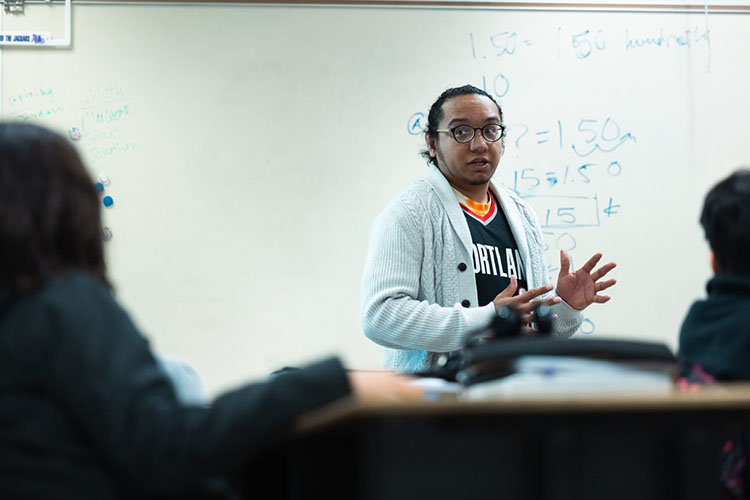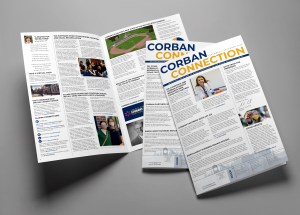When Eduardo Rodriguez first walked through the door of his new elementary school at the age of 5, he could not speak a single word of English. He had stepped into a different world, full of sights, sounds, and customs that were completely foreign. But, like every other kid in his class, he was expected to learn.
This was not uncommon for students like Rodriguez. But in spite of the incredible difficulty of his early years, Rodriguez was able to overcome. Now, as a recent graduate of Corban University’s Master of Science in Education program, he is determined to become a part of the solution, working as a bilingual educator at Lee Elementary School in South Salem.
His school is not like the one he grew up in, where he struggled for months to even understand the basics of the world around him. Lee Elementary School houses one of many bilingual education programs in the school district, and Rodriguez is one of many bilingual educators who have been equipped and trained by Corban University to make a difference.
“That ability to connect that I didn’t have, these kids are able to have right away,” Rodriguez says. “I look at our kindergartners today, and when they come in, we can dialogue with them immediately.” For Rodriguez, the fundamental basis of education is communication, and in his bilingual classrooms, he sees an immediate impact. “From the start, coming to a place where you can at least be understood and where you can use the tools you already have is super important. That’s why bilingual education is pivotal right now.”
And language is not the only barrier for second-language learners going through the education system. Cultural differences play a massive role in educational opportunities and outcomes, and are often overlooked. Rodriguez remembers moments of cultural isolation in elementary school, things as simple as bringing up authentic tacos in class only to be greeted by the vacant stare of one of his teachers. “Here, they can talk about tacos, and I know exactly what they mean, and we can break it down without talking about Taco Bell or Taco Time,” he says. “It may seem small, but that cultural bridge is huge for students.”
Fellow bilingual educator and graduate of Corban’s master’s program, Pedro Espinoza Gomez, sees the value of bilingual education in its reflection of local communities. “We live in communities that are increasingly diverse,” he says. “Having bilingual education in our schools impacts the wellbeing of our communities by placing value on people’s culture and language. Bilingual education is successful because it embraces each individual’s identity, which allows for a welcoming community.”
At Corban University, faculty take very seriously the integration of the school’s mission to train students who will impact their communities and the world for Jesus Christ. “I think we see in Scripture that God cares deeply about language and culture,” says Director of ESOL, Alexis Mendez. “From a biblical worldview, we teach our students to meet people where they are at, just as Jesus did. How much more are they able to do that by interacting in their students’ own language? We want to invest in the value of our education students’ first-language skills because we see the difference it makes.”
As a result, bilingual education isn’t just a research subject. It’s embraced, integrated, and actively modeled. Not only are educators able to plug into the current conversations around bilingual education, engaging with relevant theories and practices, they are able to secure their state- and federally-recognized ESOL (English Speakers of Other Languages) endorsements, and the University even practices bilingual education theories practically, with bilingual accommodations available for its students in the program on a case-by-case basis.
“Corban not only knows the needs of our community, but they also are willing to help their students by providing bilingual supports with the bilingual staff they have available,” says Espinoza Gomez. “Having the opportunity to study part of my M.S.Ed. with bilingual supports gave me the chance to flourish and demonstrate what I am capable of without any barriers, and helped model how to put this into practice in my own classroom.”
For America Hueramo Fuentes, a teacher in Harritt Elementary School’s dual-language immersion program, her Corban education didn’t stop purely at practical education. “Belonging to a group focused on bilingual education helped me focus on developing the skills that I and my classmates needed to be able to work in this area, but the M.S.Ed. program also reaffirmed my conviction as a teacher,” she says. “It gave me a different vision of what a teacher should be—a teacher in the model of our Lord Jesus Christ.”
Small, intimate class sizes that feature personalized attention from professors who not only know their subjects but who have practiced them extensively as primary and secondary educators themselves highlight Corban’s M.S.Ed. experience. “Our size allows us to be nimble and creative and have real relationships with our students,” Mendez says. “And we are intentional about maintaining those relationships with our graduates and continue to pour into them.”
Just as Corban helped to model and equip Rodriguez for further education, he is now doing the same for his students. After graduating from Corban’s M.S.Ed. program, his Corban professors encouraged him to continue his research at the Ph.D. level. Now, every Tuesday and Thursday after school, the students in his classroom see their teacher logging into his own classes, continuing his education. Many have even had the opportunity to say hi to his cohort and professors. “I want to show these kids that it can be attained,” Rodriguez says. “I think about how many people I know that come from where I come from and have a master’s, and there’s only a handful. So, for these kids to see someone like them, from two neighborhoods over, that has a doctorate is a big deal.”
The message is one of perseverance, prompted by an educational outlook that moves beyond the measurables and cares deeply for the human elements present in every school setting—the needs of children, and the significance of one caring adult’s impact on their lives. “My students represent a better future, and hopefully a kinder world,” Rodriguez says. “They are my why, and every time I think I can’t do this doctoral program while teaching, I remember that I have 17 kids who are going to look at me and say, ‘He couldn’t do it, so we can’t do it.’ I hope that someday I get to see them do better than me.”
This is the heart of Corban’s missional approach to bilingual education. But it does not come without its challenges. Lack of support, administrative or community buy-in or understanding, resources and curriculum, and negative political rhetoric all present significant barriers to the development of these programs, even before considering the practical challenges of second-language and dual-language learning. But the benefits to students and communities have been undeniable, which is why Corban is doing its best to lead the charge in the local educational landscape.
“Bilingual education is a highly beneficial factor for the development of a child’s intelligence,” says Hueramo Fuentes, who points to the cognitive benefits experienced in multilingual communities, not only for second language learners, but for native English-speaking students as well. As the United States lags behind much of the developed world in multilinguality, educators like Hueramo Fuentes, Espinoza Gomez, and Rodriguez see bilingual education as a vital piece to the solution. “I am blessed to help two groups in the community at the same time—Spanish speakers and English speakers,” Hueramo Fuentes says.
At the community level, bilingual and dual-language immersion programs in the Salem Keizer School District are graduating students and sending them to college and technical training schools at a much higher rate than their non-bilingual track counterparts. “If we want more successful members of society, then we need to graduate more successful members of society versus just getting them in and out of the educational program,” Rodriguez says. “Bilingual education lessens the load and produces more people who are able to have a gainful means of employment and better outcomes long-term. That’s what our society wants, people who can not only get jobs, but have productive careers. Investing in bilingual education can help resolve a lot of our societal issues.”
For Rodriguez and so many others like him, their passion begins with a shared experience of remembering what it was like to enter a world that they could not immediately understand. “If you want people to be successful, you need to give them the tools to be successful,” he says. “To ask a student to learn in a completely different language is not going to be successful.” It’s a philosophy that Corban University has taken to heart, training teachers to make a difference in the world for Jesus Christ by equipping them to meet and reach diverse communities where they are, caring for culture, and prizing the value of every individual student just as Christ would.
“When we think about equity from a teacher’s perspective, it’s eliminating as many deficits as we can now,” Rodriguez says. “It’s not about who has more and taking from them. It’s about bridging the gaps as best we can. For far too long, we have not made those bridges, and we have negative outcomes from the inability to make those changes. Now, we are looking to build those bridges, mending relationships, and trying to change the school environment to the point where everybody isn’t just welcome, but belongs.”
For more information about Corban’s M.S.Ed. degree, visit: https://www.corban.edu/academics/graduate-programs/education/master-of-science-in-education/


